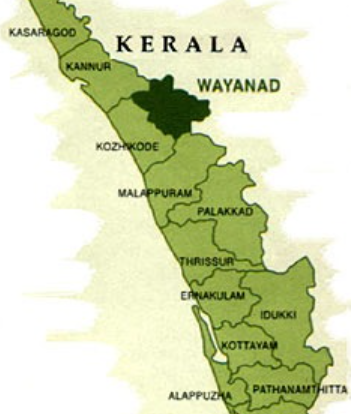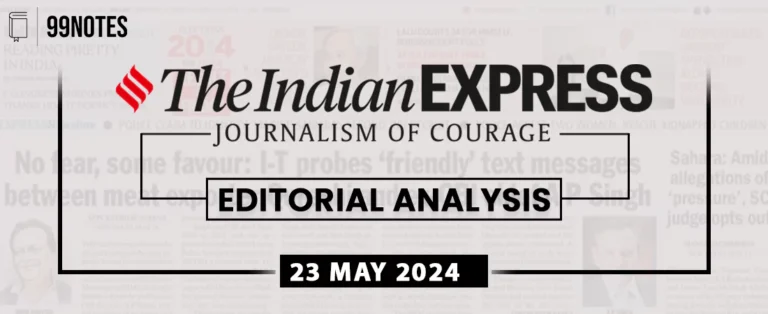14 August 2024 : Daily Current Affairs
1. The melting of polar ice due to climate change is making days longer
(Source – The Hindu, International Edition – Page No. – 7)
| Topic: GS1 – Geography – Climate change – Effects of climate change |
| Context |
|
Impact of Climate Change on Earth’s Rotation:
- Scientists have discovered that climate change is contributing to a slowing in the Earth’s rotation.
- This phenomenon is linked to the melting of polar ice caps, which has caused the Earth to spin slower.
- This slowing effect results in minuscule changes in the duration of a day, which, while not significantly affecting daily life, could impact technology reliant on precise timekeeping, such as computer networks and space travel.
Conservation of Angular Momentum:
- The phenomenon can be explained through conservation of angular momentum, a basic physics principle.
- When polar ice melts, water from the melt flows towards the equatorial regions, causing the Earth to bulge at the equator and increasing its moment of inertia.
- This results in a slower rotation rate and a slight increase in the time taken to complete one rotation, thus lengthening the day.
Recent Research Findings:
- Researchers analysed data from a 200-year period (1900-2100) and found that climate change has slowed the Earth’s rotation by about 1.3 milliseconds per century over the last two decades.
- Projections indicate that if high emission scenarios persist, this rate of slowing could double to 2.6 milliseconds per century.
- This would make climate change the dominant factor in slowing the Earth’s rotation, surpassing other influences.
| Implications for Timekeeping: |
|
Effects on Earth’s Axis:
- The melting of polar ice also affects the Earth’s axis of rotation. Research indicates that melting ice is causing the Earth’s axis to shift slightly over time.
- This shifting of the axis, combined with rising sea levels in coastal areas, underscores the broader impacts of climate change, which go beyond just slowing the Earth’s rotation.
| Practice Question: Discuss how melting polar ice due to climate change is affecting the Earth’s rotation and timekeeping systems. What are the broader implications of this phenomenon for technology and climate science? (150 Words /10 marks) |
2. An overview of governance in Delhi
(Source – The Hindu, International Edition – Page No. – 10)
| Topic: GS2 – Governance |
| Context |
|
Evolution of Delhi’s Government
- 1950: At the commencement of the Constitution, Delhi was designated as a Part C State.
- 1956: During the States Reorganisation, Delhi was made a Union Territory governed by an administrator.
- 1958: Establishment of the Municipal Corporation of Delhi (MCD).
- 1966: Limited local government established in Delhi.
- 1989: Balakrishnan Committee recommendations led to the 69th Amendment in 1991, which provided for a Legislative Assembly and a council of ministers for the National Capital Territory (NCT) of Delhi.
- 1991: The Government of NCT of Delhi Act detailed provisions for its legislature, executive, and administration. However, public order, police, and land remained under Union government control.
Issues of Conflict

- Political Tensions (Since 2015):
- Persistent conflicts between the Union government (BJP-led) and the Delhi government (AAP-led).
- Legal Disputes:
- Supreme Court judgments have led to amendments in the Government of NCT of Delhi Act.
- These amendments have restricted the powers of the Delhi government.
- Recent Developments:
- Problems such as electrocution and flooding in Delhi have intensified the conflict.
- There has been blame-shifting among elected representatives at the Union, Delhi, and local government levels.
Supreme Court Judgment and Accountability
- 2023 Supreme Court Judgment: Emphasised the triple chain of accountability in a democracy:
- Officials are accountable to ministers.
- Ministers are collectively responsible to the Legislative Assembly.
- Assembly members are accountable to the people.
- Impact: Ongoing conflicts between various government levels disrupt this chain of accountability.
Proposed Solutions:
- Restructuring Governance:
- Geographical Division: Consider a model similar to the U.S. approach for Washington DC, which is significantly smaller (177 sq km) compared to Delhi.
- Delhi’s Division:
- New Delhi Area: The area of New Delhi (50-100 sq km), which houses central government offices and embassies, could remain under full Central government control.
- Remaining Areas: The rest of Delhi could be governed by the Delhi Assembly.
Constitutional Amendment:
- Implementing this model would require a constitutional amendment after thorough deliberation and consensus.
- The proposed model should align with the 2023 Supreme Court judgement to ensure responsible and responsive governance across all levels of government.
| Practice Question: Discuss the key governance challenges faced by the National Capital Territory (NCT) of Delhi due to the existing administrative setup. (150 Words /10 marks) |
3. Does India have laws on the movement of ballast water?
(Source – The Hindu, International Edition – Page No. – 10)
| Topic: GS3 – Environment – Environmental pollution and degradation |
| Context |
|
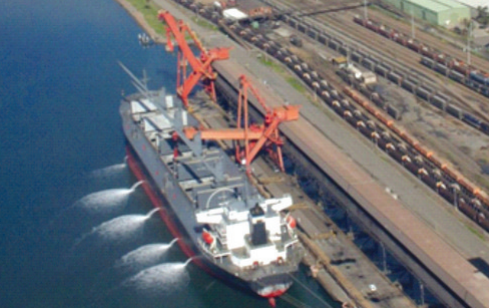
Discharging of Ballast water in harbour
| Ballast Water Explained: |
|
Seriousness of the Problem
- Invasive Species in India: Scientists have identified nearly 30 invasive species from ship ballast water in India. The charru mussel, Mytella strigata, has been particularly harmful, replacing native species in various water bodies such as Pulicat lake and Ashtamudi lake.
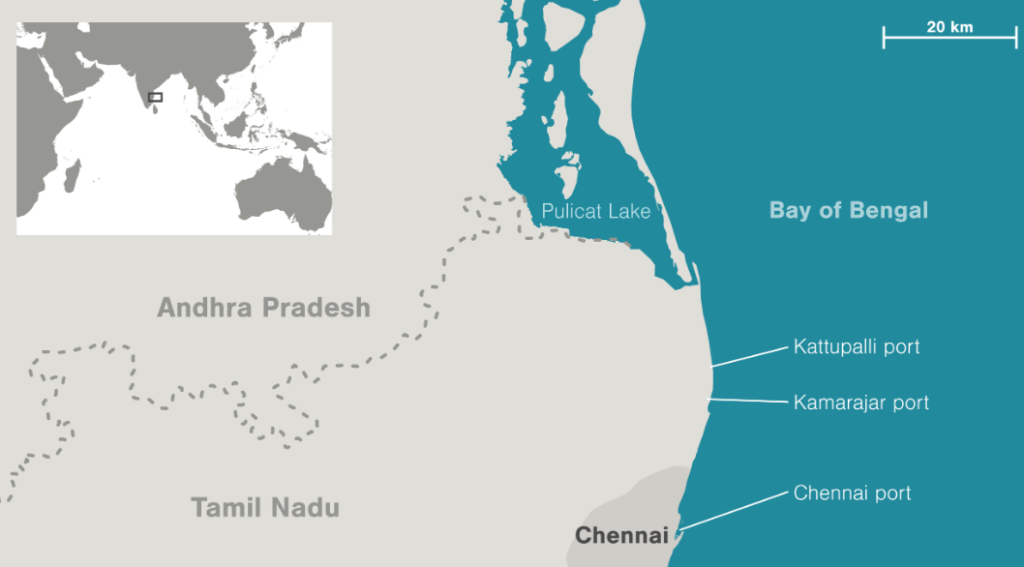
Pulicat Lake
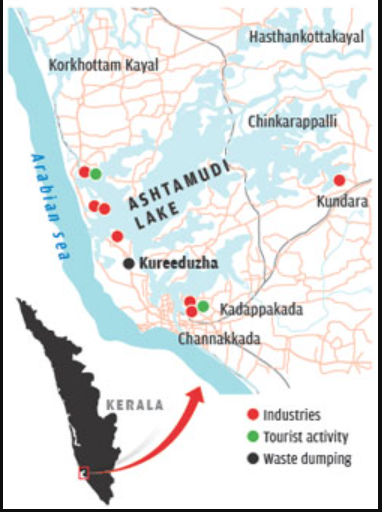
Ashtamudi lake
- Adaptability: This mussel can thrive in both marine and fresh water environments, with high survival rates and prolific egg production.
Global Regulations
- Ballast Water Management (BWM) Convention: Enforced by the International Maritime Organization (IMO) since September 8, 2017. The convention aims to prevent the spread of harmful aquatic organisms and pathogens through ballast water.
- Regulations for New Ships: New ships must use onboard ballast water management systems that treat ballast water with chemicals to eliminate organisms before discharge.
- Regulations for Older Ships: Ships built before the BWM convention must exchange ballast water with “neutral” water from the ocean before arriving at their destination.
- Countries Leading Enforcement: Australia and New Zealand enforce strict ballast water management due to their ecologically sensitive regions. Australia, in particular, implements rigorous checks on ballast water management systems at its ports.
India’s Position
- Lack of Adoption: As of July 2, 97 countries have adopted the BWM Convention, but India is not among them. This means there are no mandatory regulations for ballast water management in Indian ports.
- Current Regulations: Although there are regulations for oil discharge, ballast water discharge remains unregulated in India.
- Legal Perspective: Port authorities are seen as facilitators rather than regulators of ship traffic. Without specific laws, the liability for spreading invasive species through ballast water falls on ship owners if evidence of wrongdoing is present.
- Call for Action: It is suggested that India should sign the BWM Convention to enforce regulations and prevent further ecological damage from ballast water discharge.
| Practice Question: Discuss the environmental impact of unregulated ballast water discharge in maritime activities and evaluate the effectiveness of international regulations in mitigating these impacts. (150 Words /10 marks) |
4. Rainfall that caused Wayanad landslides influenced by climate change, shows study
(Source: Indian Express; Section: Express Network; Page: 10)
| Topic: GS1 – Geography – Climate Change – Effects of Climate Change |
| Context: |
| Landslides in Wayanad, triggered by intense rainfall on July 30, led to the deaths of over 200 people. |
Analysis of News:
What is Landslide and what Causes one?
- A landslide is defined as the movement of a mass of rock, debris, or earth down a slope.
- Landslides are a type of “mass wasting,” which denotes any down-slope movement of soil and rock under the direct influence of gravity.
- Landslides occur mainly in mountainous terrains where there are conducive conditions of soil, rock, geology and slope.
Causes
- Natural Causes that trigger it include heavy rainfall, earthquakes, snow melting and undercutting of slopes due to flooding.
- Landslides can also be caused by Anthropogenic Activities such as excavation, cutting of hills and trees, excessive infrastructure development, and overgrazing by cattle.
- In India, rainfall-induced landslide events are more common.
Rainfall:
- Wayanad recorded 140 mm of rainfall in a single day, marking the third heaviest on record for the district. This event was classified as a “once in a 50-year event.”
Study Findings:
- Human-induced climate change made the rainfall 10% heavier.
- Climate models predict an increase in the intensity of such events by another 4% under a 2°C warming scenario, heightening landslide risks.
- The study emphasizes the need for adaptation measures, such as reinforcing vulnerable slopes and establishing early warning systems.
Contributing Factors:
- Quarrying, a 62% reduction in forest cover since 1950, and inadequate assessments have heightened the region’s vulnerability to landslides.
Implications:
- There’s a growing need for stringent land-use policies, minimizing deforestation, and regulating construction activities to mitigate future disasters.
| About Wayanad |
|
|
| PYQ: Bring out the causes for more frequent landslides in the Himalayas than in Western Ghats. (100 words/5m) (UPSC CSE (M) GS-1 2013) |
| Practice Question: Examine the impact of human-induced climate change on the frequency and intensity of extreme weather events, using the recent Wayanad landslides as a case study. Discuss the role of land-use practices and suggest measures to mitigate future disasters. (250 words/15 m) |
5. Opposition Demands JPC Probe into Hindenburg Allegations Against SEBI Chief; BJP Rejects Call
(Source: Indian Express; Section: Explained; Page: 19)
| Topic: GS2 – Polity – Parliament |
| Context: |
| The Opposition has called for a Joint Parliamentary Committee (JPC) to investigate allegations by Hindenburg Research against SEBI Chairperson Madhabi Puri Buch. The BJP has rejected this demand. |
Analysis of News:
About Joint Parliamentary Committee (JPC)
- It is set up by the Parliament for a special purpose, like for the detailed scrutiny of a subject or Bill.
- It has members from both the Houses and from both the ruling parties and the opposition.
- It is dissolved after its term ends or its task has been completed.
Process of Setting up: A JPC is set up after one House of Parliament has passed a motion and the other has agreed to it.
- Members of the JPC are decided by the Parliament. The number of members can vary – there is no fixed number.
Functions: the mandate of a JPC depends on the motion constituting it.
- For example, “The terms of reference for the JPC on the stock market scam asked the committee to look into financial irregularities, to fix responsibility on persons and institutions for the scam, to identify regulatory loopholes and also to make suitable recommendations.
- To fulfill its mandate, a JPC can scrutinise documents and summon people for questioning. It then submits a report and makes recommendations to the government.
Applicability of Recommendations: While the recommendations of a JPC have persuasive value, they are not binding on the government.
- The government can choose to launch further investigations based on what the JPC has said, but it can’t be forced to do so.
- The government is required to report on the follow-up action taken on the basis of the recommendations of the JPC and other committees.
- The committees then submit ‘Action Taken Reports’ in Parliament on the basis of the government’s reply
Current Status: There have been six JPCs set up so far.
- Significance: The Opposition sees the JPC as a tool to access details of alleged scams and maintain public pressure on the government. Historically, JPCs have been formed to investigate significant financial scandals, such as the 2G spectrum scam, Ketan Parekh stock market scam, and the Harshad Mehta securities scam.
- Past Precedents: Previous JPCs on financial issues have had mixed outcomes, with some recommendations not fully implemented, leading to varying degrees of accountability and legal action.
| Practice Question: Critically examine the role and effectiveness of Joint Parliamentary Committees (JPCs) in investigating financial scandals in India. (250 words/15 m) |
Prelims Facts
1. Egg or sperm donor has no legal right on child: Bombay HC
(Source – The Hindu, International Edition – Page No. – 6)
| Context |
|
Analysis of the news:
- The Bombay High Court ruled that donating eggs or sperm does not grant the donor legal entitlement to claim parenthood.
- The case involved a woman who donated eggs to her sister and brother-in-law for surrogacy.
- After the twins were born, the donor claimed a right to parenthood due to her biological connection.
- The High Court, led by Justice Milind Jadhav, rejected this claim, citing that the donor’s role is limited to being a voluntary donor, not a legal parent.
- The court referred to the National Guidelines for ART Clinics (2005) and the Surrogacy Act, which do not recognize egg or sperm donors as legal parents.
- The court granted the petitioner access to her twin daughters, emphasising proper application of legal principles regarding parental rights.
2. AI can bridge healthcare gaps: Nasscom
(Source – The Hindu, International Edition – Page No. – 13)
| Context |
|
Analysis of the news:
- The Nasscom-Kantar report highlights that AI adoption could address accessibility, affordability, and quality issues in India’s healthcare sector.
- India’s healthcare sector is projected to reach $650 billion by 2025, driven by increased public health spending, investments in medical infrastructure, and growth in home healthcare and telemedicine.
- The sector has grown at a CAGR of 22.5% from 2016 to 2022. In contrast, AI in healthcare is expanding at a CAGR of 40.6% and is expected to reach $1.6 billion by 2025.
- Key AI applications in healthcare include drug discovery, clinical trials, and AI imaging and diagnostics.
- AI’s transformative potential includes improving diagnostics, streamlining operations, and enhancing patient care.
- Achyuta Ghosh from Nasscom Insights emphasises AI’s role in predictive analytics and precision medicine.
3. Madhya Pradesh High Court Rules Against Automatic Bail Cancellation, Emphasizes Protection of Fundamental Rights
(Source: Indian Express; Section: Express Network; Page: 10)
| Context: |
| The article talks about a recent judgement of The Madhya Pradesh High Court regarding automatic cancellation of bail. |
Analysis of News:
Fundamental Rights and Natural Justice:
- The Madhya Pradesh High Court highlighted that “automatic cancellation” of bail without a hearing infringes on a person’s fundamental rights, particularly the right to personal liberty.
- The court emphasized that any decision affecting an individual’s freedom must be preceded by a reasonable opportunity to be heard, which is a cornerstone of natural justice and enshrined in the Constitution.
Case Background:
- The issue arose from a 2022 High Court order that canceled the bail of an accused who failed to appear before the police, a condition set during his bail grant in 2021.
- The court had imposed strict conditions, including monthly appearances before the police, with a clause that missing even a single appearance would lead to automatic bail cancellation.
Judicial Review:
- Upon review, the High Court found that the automatic cancellation clause, enforced without a hearing, was unjust as it denied the accused the opportunity to explain his non-compliance.
- The court underscored that while courts have the authority to set bail conditions, those conditions must not contravene the principles of natural justice or the fundamental rights of the accused.
Implications:
- This judgment reinforces the importance of safeguarding personal liberty in legal proceedings and ensures that bail conditions do not violate constitutional protections by denying the accused a fair chance to be heard.
4. ₹1 Lakh Crore Anusandhan Kosh to Boost Deep-Tech Innovation and Self-Reliance in India
(Source: Indian Express; Section: Economy; Page: 17)
| Context: |
| The article talks about The Anusandhan Kosh fund which was announced in the interim Budget for FY25. |
Analysis of News:
- About the Fund: The Anusandhan Kosh of ₹1 lakh crore aims to provide long-term financing to support research and innovation in emerging sectors.
- Purpose: It targets the adoption of indigenous deep-tech and cutting-edge technologies in defense, energy, and electronics, offering new opportunities for India’s tech-savvy youth.
- Government Initiative: The fund, announced in the FY25 interim budget, will offer concessional capital to encourage the private sector to adopt and develop local technologies, reducing reliance on foreign tech.
- Objective: This initiative supports India’s goal of becoming a developed nation by 2047, with a focus on strengthening the defense sector and promoting self-reliance (Aatmanirbhar Bharat).
- Benefits: Companies can access low or zero-interest long-term loans with moratoriums, reducing risks associated with adopting untested Indian technologies.
5. Elon Musk Hosts Donald Trump on X Amid DDoS Attack, Leading to Delays and Glitches
(Source: Indian Express; Section: Explained; Page: 19)
| Context: |
|
Analysis of News:
What is a DDoS Attack?
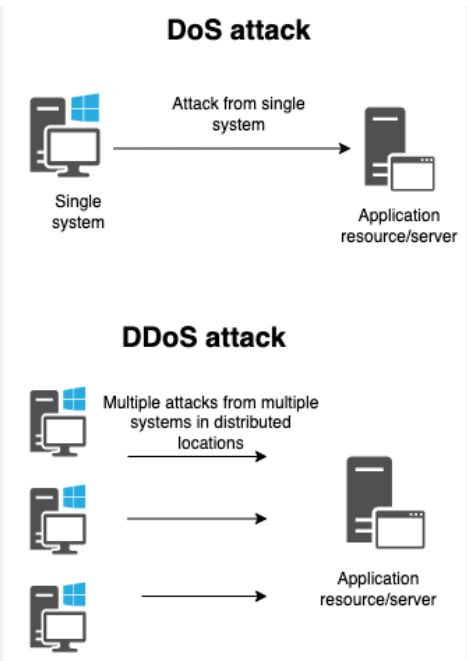
- A Denial-of-Service (DoS) attack disrupts access to a website or online service by overwhelming it with traffic, rendering it slow or inaccessible.
- A Distributed Denial-of-Service (DDoS) attack involves multiple sources attacking a single target, making it difficult to trace the attacker.
- DDoS attacks work by consuming a target’s bandwidth and resources, preventing legitimate users from accessing the service.
How Do DDoS Attacks Work?
- Smurf Attack: The attacker sends messages using the target’s IP address to multiple recipients, causing them to inadvertently flood the target’s server.
- SYN Flood: Attackers send connection requests but deliberately leave the process incomplete, causing server overload.
Signs of a DoS Attack:
- Slow internet speeds and difficulty accessing websites.
- Anti-virus software can detect unusual traffic and help prevent such attacks.
Impact:
- DDoS attacks can lead to significant disruptions, ranging from a few hours to days.
- Notable incidents include the 2016 attack that affected major websites like Spotify and Amazon.
- In this case, X faced a significant strain due to the high number of listeners, with over a million tuning in, leading to service disruptions similar to a previous incident with Ron DeSantis.
6. DRDO carries out successful maiden flight test of Long Range Glide Bomb ‘GAURAV’
(Source – https://pib.gov.in/PressReleseDetail.aspx?PRID=2044995
| Context |
|
Analysis of the news:
- The Defence Research and Development Organisation (DRDO) conducted a maiden flight test of the long-range glide bomb (LRGB) named Gaurav.
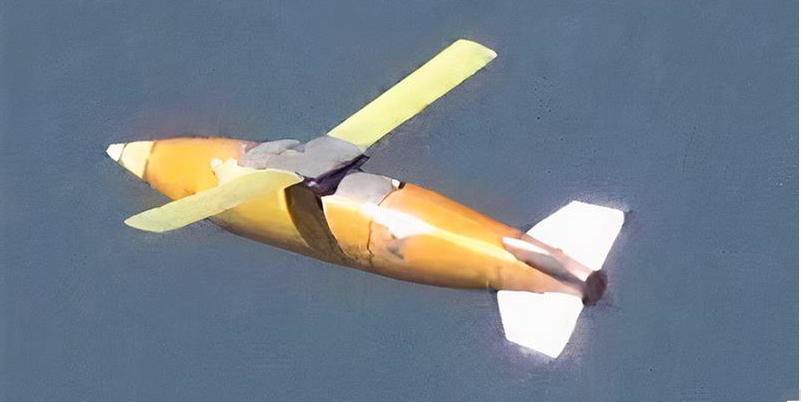
- The test was carried out from a Su-30 MK-I fighter jet of the Indian Air Force off the coast of Odisha.
- Gaurav is a 1,000 kg class air-launched glide bomb with long-range capability.
- It uses a highly accurate hybrid navigation scheme to steer towards its target.
- The bomb was designed and developed indigenously by the Research Centre Imarat in Hyderabad.
- During the test, Gaurav hit its target on Long Wheeler’s island with pinpoint accuracy.
7. Bureau of Indian Standards organises workshop on ‘Standardisation for Environment and Ecology’
(Source – https://pib.gov.in/PressReleseDetail.aspx?PRID=2044735 )
| Context |
|
Bureau of Indian Standards (BIS):
- Establishment: The Bureau of Indian Standards (BIS) was established under the Bureau of Indian Standards Act, 1986.
- Function: BIS is the national standards body of India, responsible for the development and maintenance of standards for products, services, and systems.
- Objectives: Its main objectives are to ensure quality, safety, and reliability in products and services, protect consumer interests, and facilitate trade.
- Certification: BIS provides certification for products and systems under various schemes, including the ISI mark for products and the ISO certification for management systems.
- Standards Development: It develops and updates standards in collaboration with stakeholders from industry, government, and academia.
- Research: It also conducts research to support standardisation activities and improve existing standards.

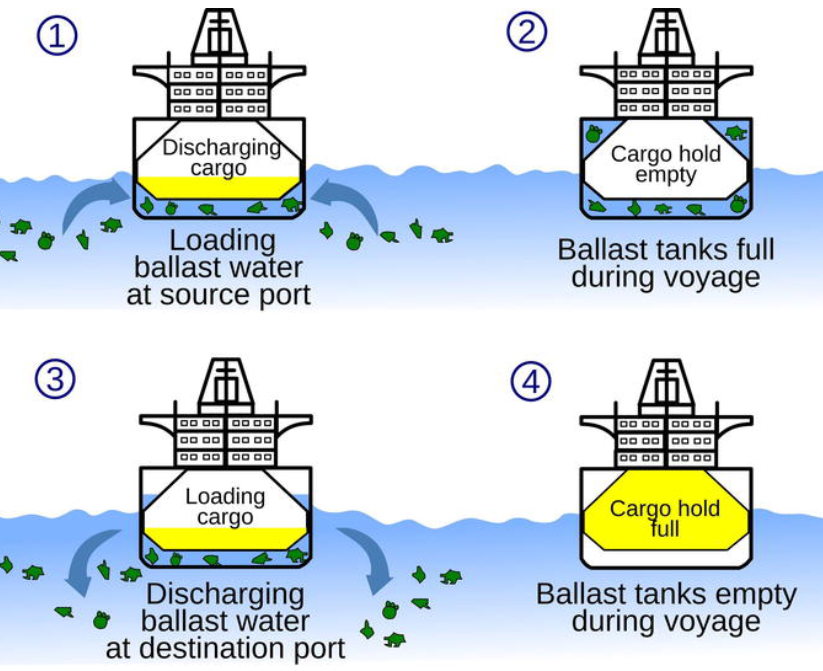 Purpose: Ballast water is used by ships to maintain stability. When a ship unloads cargo, it takes in sea water as ballast to ensure proper immersion. Conversely, when cargo is loaded, ballast water is expelled.
Purpose: Ballast water is used by ships to maintain stability. When a ship unloads cargo, it takes in sea water as ballast to ensure proper immersion. Conversely, when cargo is loaded, ballast water is expelled.